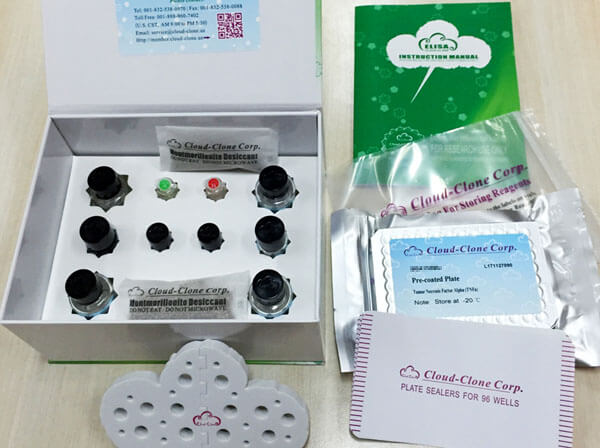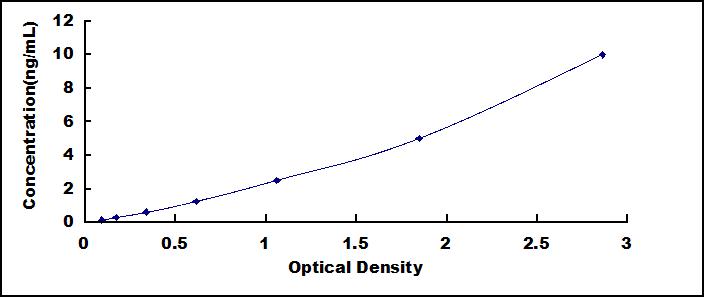ELISA Kit for Peroxisome Proliferator Activated Receptor Gamma (PPARg) 

PPAR-G; PPARG1; PPARG2; NR1C3; Glitazone Receptor; Nuclear Receptor Subfamily 1 Group C Member 3
- UOM
- FOB US$ 479.00 US$ 684.00 US$ 3,078.00 US$ 5,814.00 US$ 47,880.00
- Quantity
Overview
Properties
- Product No.SEA886Ra
- Organism SpeciesRattus norvegicus (Rat) Same name, Different species.
- ApplicationsEnzyme-linked immunosorbent assay for Antigen Detection.
Research use only - DownloadInstruction Manual
- CategoryMetabolic pathwayEndocrinologyCardiovascular biologyDevelopmental scienceBone metabolism
Sign into your account
Share a new citation as an author
Upload your experimental result
Review

Contact us
Please fill in the blank.
Recovery
Matrices listed below were spiked with certain level of recombinant Peroxisome Proliferator Activated Receptor Gamma (PPARg) and the recovery rates were calculated by comparing the measured value to the expected amount of Peroxisome Proliferator Activated Receptor Gamma (PPARg) in samples.
| Matrix | Recovery range (%) | Average(%) |
| serum(n=5) | 90-102 | 96 |
| EDTA plasma(n=5) | 87-94 | 90 |
| heparin plasma(n=5) | 90-103 | 94 |
Precision
Intra-assay Precision (Precision within an assay): 3 samples with low, middle and high level Peroxisome Proliferator Activated Receptor Gamma (PPARg) were tested 20 times on one plate, respectively.
Inter-assay Precision (Precision between assays): 3 samples with low, middle and high level Peroxisome Proliferator Activated Receptor Gamma (PPARg) were tested on 3 different plates, 8 replicates in each plate.
CV(%) = SD/meanX100
Intra-Assay: CV<10%
Inter-Assay: CV<12%
Linearity
The linearity of the kit was assayed by testing samples spiked with appropriate concentration of Peroxisome Proliferator Activated Receptor Gamma (PPARg) and their serial dilutions. The results were demonstrated by the percentage of calculated concentration to the expected.
| Sample | 1:2 | 1:4 | 1:8 | 1:16 |
| serum(n=5) | 90-97% | 86-103% | 96-105% | 96-105% |
| EDTA plasma(n=5) | 85-92% | 88-103% | 85-97% | 98-105% |
| heparin plasma(n=5) | 87-96% | 83-102% | 88-95% | 89-104% |
Stability
The stability of kit is determined by the loss rate of activity. The loss rate of this kit is less than 5% within the expiration date under appropriate storage condition.
To minimize extra influence on the performance, operation procedures and lab conditions, especially room temperature, air humidity, incubator temperature should be strictly controlled. It is also strongly suggested that the whole assay is performed by the same operator from the beginning to the end.
Reagents and materials provided
| Reagents | Quantity | Reagents | Quantity |
| Pre-coated, ready to use 96-well strip plate | 1 | Plate sealer for 96 wells | 4 |
| Standard | 2 | Standard Diluent | 1×20mL |
| Detection Reagent A | 1×120µL | Assay Diluent A | 1×12mL |
| Detection Reagent B | 1×120µL | Assay Diluent B | 1×12mL |
| TMB Substrate | 1×9mL | Stop Solution | 1×6mL |
| Wash Buffer (30 × concentrate) | 1×20mL | Instruction manual | 1 |
Assay procedure summary
1. Prepare all reagents, samples and standards;
2. Add 100µL standard or sample to each well. Incubate 1 hours at 37°C;
3. Aspirate and add 100µL prepared Detection Reagent A. Incubate 1 hour at 37°C;
4. Aspirate and wash 3 times;
5. Add 100µL prepared Detection Reagent B. Incubate 30 minutes at 37°C;
6. Aspirate and wash 5 times;
7. Add 90µL Substrate Solution. Incubate 10-20 minutes at 37°C;
8. Add 50µL Stop Solution. Read at 450nm immediately.

Test principle
The test principle applied in this kit is Sandwich enzyme immunoassay. The microtiter plate provided in this kit has been pre-coated with an antibody specific to Peroxisome Proliferator Activated Receptor Gamma (PPARg). Standards or samples are then added to the appropriate microtiter plate wells with a biotin-conjugated antibody specific to Peroxisome Proliferator Activated Receptor Gamma (PPARg). Next, Avidin conjugated to Horseradish Peroxidase (HRP) is added to each microplate well and incubated. After TMB substrate solution is added, only those wells that contain Peroxisome Proliferator Activated Receptor Gamma (PPARg), biotin-conjugated antibody and enzyme-conjugated Avidin will exhibit a change in color. The enzyme-substrate reaction is terminated by the addition of sulphuric acid solution and the color change is measured spectrophotometrically at a wavelength of 450nm ± 10nm. The concentration of Peroxisome Proliferator Activated Receptor Gamma (PPARg) in the samples is then determined by comparing the O.D. of the samples to the standard curve.
Giveaways
Increment services
-
 Single-component Reagents of Assay Kit
Single-component Reagents of Assay Kit
-
 Lysis Buffer Specific for ELISA / CLIA
Lysis Buffer Specific for ELISA / CLIA
-
 Quality Control of Kit
Quality Control of Kit
-
 ELISA Kit Customized Service
ELISA Kit Customized Service
-
 Disease Model Customized Service
Disease Model Customized Service
-
 Serums Customized Service
Serums Customized Service
-
 TGFB1 Activation Reagent
TGFB1 Activation Reagent
-
 Real Time PCR Experimental Service
Real Time PCR Experimental Service
-
 Streptavidin
Streptavidin
-
 Fast blue Protein Stain solution
Fast blue Protein Stain solution
-
 Single-component Reagents of FLIA Kit
Single-component Reagents of FLIA Kit
-
 Streptavidin-Agarose Beads
Streptavidin-Agarose Beads
Citations
- Elevated levels of PPAR-gamma in the cerebrospinal fluid of patients with multiple sclerosisPubmed: 24021801
- Nonivamide enhances miRNA let‐7d expression and decreases adipogenesis PPARγ expression in 3T3‐L1 cellsPubmed:25704235
- Establishment of a rabbit model to study the influence of advanced glycation end products accumulation on osteoarthritis and the protective effect of pioglitazonePubMed: 26321377
- Evaluation of Protein Kinase Cβ and PPARγ Activity in Diabetic Rats Supplemented with Momordica charantiapmc:PMC4866090
- Evaluation of Protein Kinase Cβ and PPARγ Activity in Diabetic RatsSupplemented with Momordica charantia.pubmed:27190792
- Establishment of a rabbit model to study the influence of advanced glycation end productsaccumulation on osteoarthritis and the protective effect of pioglitazone.pubmed:26321377
- Unlike PPARgamma, neither other PPARs nor PGC-1alpha is elevated in the cerebrospinal fluid of patients with multiple sclerosispubmed:28483651
- Engulfment of Hb‐activated platelets differentiates monocytes into pro‐inflammatory macrophages in PNH patientsPubmed:29677388
- Simpson–Golabi–Behmel syndrome human adipocytes reveal a changing phenotype throughout differentiationPubmed:29574488
- Maternal omega-3 fatty acids and vitamin E improve placental angiogenesis in late-onset but not early-onset preeclampsiaPubmed: 31420792
- Hyperglycemia Changes Expression of Key Adipogenesis Markers (C/EBPα and PPARᵞ) and Morphology of Differentiating Human Visceral AdipocytesPubmed: 31398873
- Indomethacin and juglone inhibit inflammatory molecules to induce apoptosis in colon cancer cellsPubmed: 31916655
- In©\vitro effect of pine bark extract on melanin synthesis, tyrosinase activity, production of endothelin©\1 and PPAR in cultured melanocytes exposed to Ultraviolet?¡33960120
- TRPA1 Agonist Cinnamaldehyde Decreases Adipogenesis in 3T3-L1 Cells More Potently than the Non-agonist Structural Analog Cinnamyl Isobutyrate33403292
- Quantitative real-time measurement of endothelin-1-induced contraction in single non-activated hepatic stellate cells34343209
- Maternal Vitamin D Deficiency Reduces Docosahexaenoic Acid, Placental Growth Factor and Peroxisome Proliferator Activated Receptor Gamma levels in the Pup …34768025
- Melatonin attenuates cisplatin-induced acute kidney injury in mice: Involvement of PPARα and fatty acid oxidationPubmed:35367536








